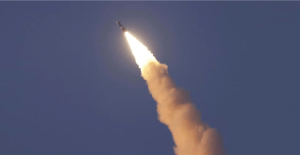North Korea’s New ICBM: Is It Really the ‘World’s Strongest’?
North Korea has unveiled its latest intercontinental ballistic missile (ICBM), the Hwasong-19, claiming it to be the “world’s strongest.” While the missile has demonstrated impressive range, experts question its practical wartime use due to its size and potential vulnerability. The launch has escalated tensions in the region, prompting condemnation from the U.S., South Korea, and Japan.
CONTENTS

North Korea’s New ICBM: Is It Really the ‘World’s Strongest’?
North Korea boasts world’s strongest ICBM
North Korea’s New ICBM: Is It Really North Korea’s New ICBM: Is It Really the ‘World’s Strongest’?On November 1, North Korea announced that its recent intercontinental ballistic missile (ICBM) test featured “the world’s strongest” missile—a claim experts largely dismiss as propaganda, according to the Associated Press. Experts say the missile’s large size limits its practicality for real-world combat use. Named Hwasong-19, the missile reportedly achieved greater altitude and flight duration than any prior North Korean weapon. However, analysts argue that this test does not confirm that North Korea has solved the technical challenges necessary for operational ICBMs capable of reaching the continental United States.
The North’s state-run Korean Central News Agency (KCNA) described the Hwasong-19 as “the world’s strongest strategic missile” and “a perfected weapon system.” Leader Kim Jong Un was said to have overseen the launch, viewing it as a message of North Korea’s determination to counter perceived threats.
Observers of the launch noted that the missile’s exhaust color and flame pattern suggest it likely uses solid fuel, which offers better mobility and makes detection more challenging compared to liquid-fueled missiles that need pre-launch fueling. While South Korean officials hinted that the test might involve solid-fuel technology, KCNA did not confirm the propellant type. Experts, however, believe official images support the solid-fuel assessment, which would allow quicker, more concealable launches. The Hwasong-18 was previously North Korea’s most advanced ICBM.
On Friday, North Korea claimed that its latest intercontinental ballistic missile (ICBM) test, the Hwasong-19, is “the world’s strongest,” a statement that experts view as exaggerated propaganda, noting the missile’s unwieldy size limits its practical wartime use. The missile, launched Thursday, reached a record altitude and duration, but analysts say the test didn’t confirm that North Korea has resolved essential technological hurdles to deploy ICBMs capable of striking the U.S. mainland.
North Korea’s state-run Korean Central News Agency (KCNA) labeled the Hwasong-19 as “the world’s strongest strategic missile” and a “perfected weapon system,” with leader Kim Jong Un observing the launch. KCNA highlighted it as a show of resolve against external security threats. Images of the launch suggest the missile uses solid fuel, offering enhanced mobility and reduced detection time compared to liquid-fueled missiles that require pre-launch fueling. Experts, however, question the missile’s wartime mobility, as both the missile and its launch vehicle appear oversized, which could limit maneuverability and increase vulnerability.
According to Chang Young-keun of Seoul’s Korea Research Institute for National Strategy, the Hwasong-19 measures over 28 meters—substantially longer than advanced U.S. and Russian ICBMs, which are generally under 20 meters. This size may have allowed South Korean intelligence to detect the launch in advance, posing survivability issues in wartime due to potential targeting by preemptive strikes. Some analysts, like Lee Illwoo of the Korea Defense Network, suggest the missile’s larger build may allow it to carry heavier or multiple warheads, possibly explaining why it may have been tested with a non-explosive, lighter payload to achieve a higher altitude.
Despite claims of steady advancements in North Korea’s nuclear program, analysts believe the country has yet to overcome critical barriers, such as reliable warhead reentry, precise guidance systems, and deploying multiple warheads to evade missile defenses. Developing reentry technology remains a key objective, but North Korea appears focused on extending range rather than resolving reentry issues, which may indicate remaining doubts about this capability.
The launch follows recent unverified North Korean weapons claims, which have often met skepticism. In June, North Korea claimed to have tested a multi-warhead missile, but South Korea reported a failed launch. Similarly, a test of a “super-large warhead” in July was seen by South Korea as an attempt to cover up another botched launch.
In response, South Korea, the U.S., and Japan condemned the launch as a breach of U.N. Security Council resolutions and vowed to reinforce measures to disrupt North Korea’s revenue streams for its weapons programs. South Korea’s Foreign Ministry announced sanctions against 11 North Korean individuals and four organizations tied to missile component procurement and foreign currency generation to fund Pyongyang’s weapons projects. Though symbolic, these sanctions underscore continued tensions.
Additionally, South Korea and the U.S. conducted their first live-fire drill using unmanned aerial vehicles, including South Korea’s RQ-4B Global Hawk and the U.S. MQ-9 Reaper, as a show of readiness against North Korean threats. Observers suggest that this ICBM launch, the first in nearly a year, was aimed at drawing U.S. attention days before the presidential election and responding to criticism over North Korea’s reported troop dispatch to aid Russia in Ukraine. This growing North Korea-Russia military collaboration raises concerns that North Korea might seek advanced Russian technology to bolster its nuclear and missile capabilities.
North Korea missile threatens U.S. mainland
North Korea’s New ICBM: Is It Really North Korea’s new intercontinental ballistic missile, the Hwasong-19, has raised concerns in the U.S., South Korea, and Japan, as state media KCNA reported the solid-fuel missile reached a maximum altitude of 7,687 kilometers. Experts suggest that if launched on a horizontal trajectory, the missile could potentially reach the U.S. mainland. Following the launch, the U.S. condemned North Korea’s actions, urging it to halt such destabilizing activities.
North Korea tests final ICBM version
North Korea’s New ICBM: Is It Really On Friday, North Korea announced that it had test-fired its latest intercontinental ballistic missile, the Hwasong-19, the previous day, describing it as the “final and complete version,” according to Yonhap News Agency.
Check out TimesWordle.com for all the latest news
You must be logged in to post a comment.